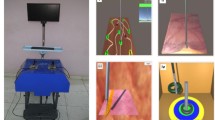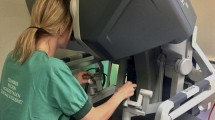Abstract
Background
Virtual-reality (VR) simulator training has been shown to improve surgical performance in laparoscopic procedures in the operating room. We have, in a randomised controlled trial, demonstrated transferability to real operations. The validity of the LapSim virtual-reality simulator as an assessment tool has been demonstrated in several reports. However, an unanswered question regarding simulator training is the durability, or retention, of skills acquired during simulator training. The aim of the present study is to assess the retention of skills acquired using the LapSim VR simulator, 6 and 18 months after an initial training course.
Methods and materials
The investigation was designed as a 6- and 18-month follow-up on a cohort of participants who earlier participated in a skills training programme on the LapSim VR. The follow-up cohort consisted of trainees and senior consultants allocated to two groups: (1) novices (experience < 5 procedures, n = 9) and (2) experts (experience > 200 procedures during the past 3 years, n = 10). Each participant performed ten sessions. Assessment of skills was based on time, economy of movement and the error parameter “bleeding”. The novice group were re-tested after 6 and 18 months, whereas the expert group were only retested once, after 6 months. None of the novices performed laparoscopic surgery in the follow-up period. The experts continued their daily work with laparoscopic surgery.
Results and conclusions
Novices showed retention of skills after 6 months. After 18 months, novices’ laparoscopic skills had returned to the pre-training level. This indicates that laparoscopic skills seemed to deteriorate in the period between 6 and 18 months without training. Experts showed consistent performance over time. This information can be included when planning training curricula in minimal invasive surgery.



Similar content being viewed by others
References
Larsen CR, Soerensen JL, Grantcharov TP, Dalsgaard T, Schouenborg L, Ottosen C, Schroeder TV, Ottesen BS (2009) Effect of virtual reality training on laparoscopic surgery: randomised controlled trial. BMJ 338:b1802
Hyltander A, Liljegren E, Rhodin PH, Lonroth H (2002) The transfer of basic skills learned in a laparoscopic simulator to the operating room. Surg Endosc 16(9):1324–1328
Youngblood PL, Srivastava S, Curet M, Heinrichs WL, Dev P, Wren SM (2005) Comparison of training on two laparoscopic simulators and assessment of skills transfer to surgical performance. J Am Coll Surg 200(4):546–551
Grantcharov TP, Kristiansen VB, Bendix J, Bardram L, Rosenberg J, Funch-Jensen P (2004) Randomized clinical trial of virtual reality simulation for laparoscopic skills training. Br J Surg 91(2):146–150
Seymour NE, Gallagher AG, Roman SA, O’Brien MK, Bansal VK, Andersen DK, Satava RM (2002) Virtual reality training improves operating room performance: results of a randomized, double-blinded study. Ann Surg 236(4):458–463
Ahlberg G, Enochsson L, Gallagher AG, Hedman L, Hogman C, McClusky DA III, Ramel S, Smith CD, Arvidsson D (2007) Proficiency-based virtual reality training significantly reduces the error rate for residents during their first 10 laparoscopic cholecystectomies. Am J Surg 193(6):797–804
Aggarwal R, Tully A, Grantcharov T, Larsen CR, Miskry T, Farthing A, Darzi A (2006) Virtual reality simulation training can improve technical skills during laparoscopic salpingectomy for ectopic pregnancy. Br J Obstet Gynaecol 113(12):1382–1387
Duffy AJ, Hogle NJ, McCarthy H, Lew JI, Egan A, Christos P, Fowler DL (2005) Construct validity for the LAPSIM laparoscopic surgical simulator. Surg Endosc 19(3):401–405
Eriksen JR, Grantcharov T (2005) Objective assessment of laparoscopic skills using a virtual reality stimulator. Surg Endosc 19(9):1216–1219
Larsen CR, Grantcharov T, Aggarwal R, Tully A, Sorensen JL, Dalsgaard T, Ottesen B (2006) Objective assessment of gynecologic laparoscopic skills using the LapSimGyn virtual reality simulator. Surg Endosc 20(9):1460–1466
Woodrum DT, Andreatta PB, Yellamanchilli RK, Feryus L, Gauger PG, Minter RM (2006) Construct validity of the LapSim laparoscopic surgical simulator. Am J Surg 191(1):28–32
Patrick J (1992) Training: research and practice. Academic Press, London; San Diego
Trevisanuto D, Ferrarese P, Cavicchioli P, Fasson A, Zanardo V, Zacchello F (2005) Knowledge gained by pediatric residents after neonatal resuscitation program courses. Paediatr Anaesth 15(11):944–947
Woollard M, Whitfeild R, Smith A, Colquhoun M, Newcombe RG, Vetteer N, Chamberlain D (2004) Skill acquisition and retention in automated external defibrillator (AED) use and CPR by lay responders: a prospective study. Resuscitation 60(1):17–28
Crofts JF, Bartlett C, Ellis D, Hunt LP, Fox R, Draycott TJ (2007) Management of shoulder dystocia: skill retention 6 and 12 months after training. Obstet Gynecol 110(5):1069–1074
Sorensen JL, Lokkegaard E, Johansen M, Ringsted C, Kreiner S, McAleer S (2009) The implementation and evaluation of a mandatory multi-professional obstetric skills training program. Acta Obstet Gynecol Scand 88(10):1107–1117
Berden HJ, Willems FF, Hendrick JM, Pijls NH, Knape JT (1993) How frequently should basic cardiopulmonary resuscitation training be repeated to maintain adequate skills? Biol Med J 306(6892):1576–1577
Stefanidis D, Korndorffer JR Jr, Sierra R, Touchard C, Dunne JB, Scott DJ (2005) Skill retention following proficiency-based laparoscopic simulator training. Surgery 138(2):165–170
Stefanidis D, Korndorffer JR Jr, Markley S, Sierra R, Scott DJ (2006) Proficiency maintenance: impact of ongoing simulator training on laparoscopic skill retention. J Am Coll Surg 202(4):599–603
Kaczorowski J, Levitt C, Hammond M, Outerbridge E, Grad R, Rothman A, Graves L (1998) Retention of neonatal resuscitation skills and knowledge: a randomized controlled trial. Fam Med 30(10):705–711
Levitt C, Kaczorowski J, Outerbridge E, Jimenez V, Connolly B, Slapcoff B (1996) Knowledge gained following Neonatal Resuscitation Program courses. Fam Med 28(6):403–406
Wayne DB, Siddall VJ, Butter J, Fudala MJ, Wade LD, Feinglass J, McGaghie WC (2006) A longitudinal study of internal medicine residents’ retention of advanced cardiac life support skills. Acad Med 81(10 Suppl):S9–S12
Tuttle RP, Cohen MH, Augustine AJ, Novotny DF, Delgado E, Dongilli TA, Lutz JW, DeVita MA (2007) Utilizing simulation technology for competency skills assessment and a comparison of traditional methods of training to simulation-based training. Respir Care 52(3):263–270
Magill RA (2009) Motor learning and control, 8th edn. McGraw-Hill, Ohio
Lynagh M, Burton R, Sanson-Fisher R (2007) A systematic review of medical skills laboratory training: where to from here? Med Educ 41(9):879–887
Wulf G, Shea C, Lewthwaite R (2010) Motor skill learning and performance: a review of influential factors. Med Educ 44(1):75–84
Arthur W, Bennett W, Stanush P, McNelly T (1998) Factors that influence skill decay and retention: a quantitative review and analysis. Hum Perform 11:57–101
Gurusamy KS, Aggarwal R, Palanivelu L, Davidson BR (2009) Virtual reality training for surgical trainees in laparoscopic surgery. Cochrane Database Syst Rev (1):CD006575
Disclosures
Authors M. Maagaard, J.L. Sorensen, J. Oestergaard, T. Dalsgaard, B. Ottesen, T. Grantcharov and C.R. Larsen have no conflicts of interest or financial ties to disclose.
Author information
Authors and Affiliations
Corresponding author
Rights and permissions
About this article
Cite this article
Maagaard, M., Sorensen, J.L., Oestergaard, J. et al. Retention of laparoscopic procedural skills acquired on a virtual-reality surgical trainer. Surg Endosc 25, 722–727 (2011). https://doi.org/10.1007/s00464-010-1233-5
Received:
Accepted:
Published:
Issue Date:
DOI: https://doi.org/10.1007/s00464-010-1233-5




